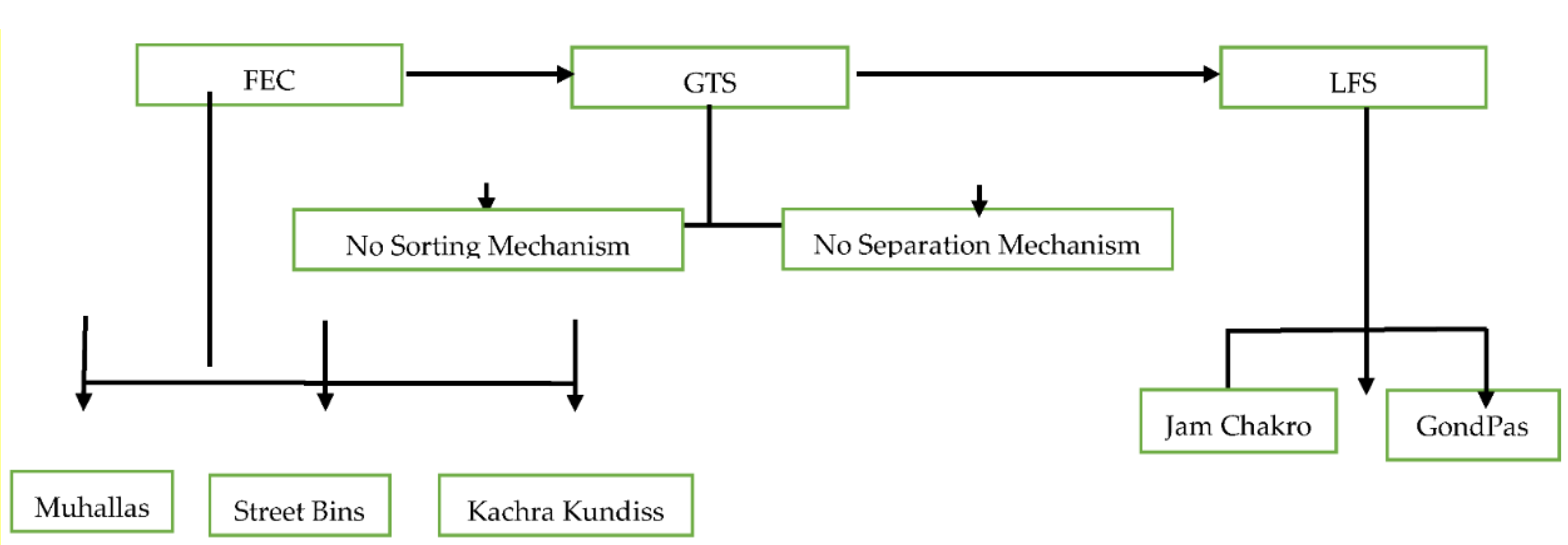Municipal Solid Waste Management and Waste to Energy in Karachi Pakistan †
Abstract
:1. Introduction
2. Energy from Solid Waste
3. Solid Wastes and Their Key Components
4. Conclusions and Solutions
Conflicts of Interest
References
- Korai, M.S.; Mahar, R.B.; Uqaili, M.A. The feasibility of municipal solid waste for energy generation and its existing management practices in Pakistan. Renew. Sustain. Energy Rev. 2017, 72, 338–353. [Google Scholar] [CrossRef]
- Sohoo, I.; Ritzkowski, M.; Heerenklage, J.; Kuchta, K. Biochemical methane potential assessment of municipal solid waste generated in Asian cities: A case study of Karachi, Pakistan. Renew. Sustain. Energy Rev. 2021, 135, 110175. [Google Scholar] [CrossRef]
- Khan, S.; Alvarez, L.C.M.; Wei, Y. Sustainable management of municipal solid waste under changing climate: A case study of Karachi, Pakistan. Asian J. Environ. Biotechnol. 2018, 2, 23–32. [Google Scholar]
- Siddiqi, M.M.; Naseer, M.N.; Abdul Wahab, Y.; Hamizi, N.A.; Badruddin, I.A.; Chowdhury, Z.Z.; Akbarzadeh, O.; Johan, M.R.; Khan, T.M.; Kamangar, S. Evaluation of municipal solid wastes based energy potential in urban Pakistan. Processes 2019, 7, 848. [Google Scholar] [CrossRef] [Green Version]
- Korai, M.S.; Mahar, R.B.; Uqaili, M.A. Optimization of waste to energy routes through biochemical and thermochemical treatment options of municipal solid waste in Hyderabad, Pakistan. Energy Convers. Manag. 2016, 124, 333–343. [Google Scholar] [CrossRef]
- Umar, U.A.; Shafiq, N.; Ahmad, F.A. A case study on the effective implementation of the reuse and recycling of construction & demolition waste management practices in Malaysia. Ain Shams Eng. J. 2021, 12, 283–291. [Google Scholar]

| Agriculture, forestry (a) | 1905 | 2004 |
| Mining (b) | 267 | 606 |
| Manufacturing | 9549 | 9593 |
| Electricity, gas, water services | 902 | 724 |
| Waste management services (c) | 34 | 27 |
| Construction | 16,055 | 14,491 |
| All other industries (d) | 11,181 | 9948 |
| Industry total | 39,893 | 37,393 |
| Public administration | 847 | 690 |
| Households | 12,459 | 14,269 |
| Imports | 554 | 685 |
| Total supply of waste | 53,753 | 53,036 |
| Recyclable Waste | Non-Recyclable Waste |
|---|---|
| Newspapers | Garbage |
| Mixed Paper | Food waste |
| Glossy Magazines and Ads | Food-tainted items |
| Cardboard | Ceramics and kitchenware |
| Paperboard | Windows and mirrors |
| Plastic Drink Bottles | Plastic wrap |
| Plastic Product Bottles | Peanut packaging and bubble wrap |
| Aluminum Cans | Wax boxes |
| Tissue boxes | Crystal |
| Shoeboxes | Tissue paper |
| Books | Light bulbs |
| Milk jugs | Foam materials |
Publisher’s Note: MDPI stays neutral with regard to jurisdictional claims in published maps and institutional affiliations. |
© 2021 by the authors. Licensee MDPI, Basel, Switzerland. This article is an open access article distributed under the terms and conditions of the Creative Commons Attribution (CC BY) license (https://creativecommons.org/licenses/by/4.0/).
Share and Cite
Ahmed, A.; Hussain, A.; Thahrani, S.; Ahmed, S.; Khoso, A.Q.; Soomro, B. Municipal Solid Waste Management and Waste to Energy in Karachi Pakistan. Eng. Proc. 2021, 12, 19. https://doi.org/10.3390/engproc2021012019
Ahmed A, Hussain A, Thahrani S, Ahmed S, Khoso AQ, Soomro B. Municipal Solid Waste Management and Waste to Energy in Karachi Pakistan. Engineering Proceedings. 2021; 12(1):19. https://doi.org/10.3390/engproc2021012019
Chicago/Turabian StyleAhmed, Aftab, Arshad Hussain, Shehdev Thahrani, Sultan Ahmed, Abdul Qadeer Khoso, and Bilal Soomro. 2021. "Municipal Solid Waste Management and Waste to Energy in Karachi Pakistan" Engineering Proceedings 12, no. 1: 19. https://doi.org/10.3390/engproc2021012019
APA StyleAhmed, A., Hussain, A., Thahrani, S., Ahmed, S., Khoso, A. Q., & Soomro, B. (2021). Municipal Solid Waste Management and Waste to Energy in Karachi Pakistan. Engineering Proceedings, 12(1), 19. https://doi.org/10.3390/engproc2021012019





